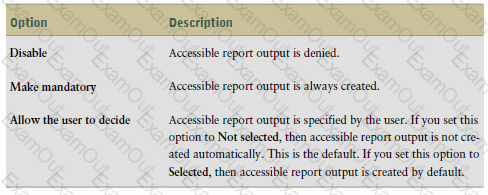The database containing the Content Store crashed. The administrator needs to restore the Content Store in its entirely including all of the configuration settings that were defined.
What must be done to recover the configuration settings?
An administrator wants to use one of the sample audit reports to view the percentage of successful and failed requests for the current day.
What must be done before they can successfully run this report?
An administrator is implementing security by modifying access to the secured functions and secured features.
Which statement is true?
All users have unrestricted access in a secured environment.
What must be modified to control this access?
Which statement is true about the Default User Profile?
An administrator has a requirement to specify system-wide accessibility settings for all entries (reports, jobs and schedules).
How can this be done?
An administrator is implementing security by managing and working with the Cognos namespace.
Which statement is true?
An environment has two dispatchers with report servers installed on two machines with following configuration:
Dispatcher 1 on Computer A
RAM: 16384 MB
CPU: 2 Core 2.0 GHz
Storage: 512 GB
Dispatcher 2 on Computer B
RAM: 32768 MB
CPU: 4 Core 3.4 GHz
Storage: 1024 GB
What should the setting of processing capacity for Dispatcher 2 be set to, if the capacity for Dispatcher 1 is set to 1?
An administrator is evaluating system status using the Scorecard pane on the Status > System page in the IBM Cognos Administration console.
Which statement is true?
An administrator created a Content Store export and included the user account information.
How can a listing of the content be exported?


